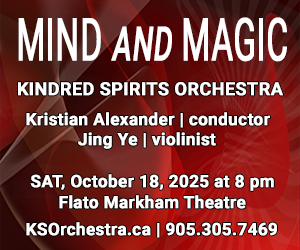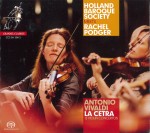 Baroque specialist Rachel Podger is in magnificent form on a new 2-CD set of Vivaldi’s La Cetra – 12 Violin Concertos Op.9, with matching support from the Holland Baroque Society (Channel Classics CCS SA 33412). Podger is technically superb in all respects in concertos which demand a very high level of playing, managing to make them sound effortless but never empty and crystal clear and precise without ever lacking warmth. The outstanding accompaniment is lively, bright and full of dynamic contrast, with a continuo group consisting of organ and two lutes in addition to the usual cello and harpsichord sounding particularly effective in the solo violin passages. There’s the usual Vivaldi display of seemingly endless circles of fifths, scale and arpeggio passages and sequences, of course, plus the false familiarity — there are moments when you could swear you’ve put the Four Seasons on by mistake — but these are concertos that have enough variation to easily hold your interest throughout the two discs.
Baroque specialist Rachel Podger is in magnificent form on a new 2-CD set of Vivaldi’s La Cetra – 12 Violin Concertos Op.9, with matching support from the Holland Baroque Society (Channel Classics CCS SA 33412). Podger is technically superb in all respects in concertos which demand a very high level of playing, managing to make them sound effortless but never empty and crystal clear and precise without ever lacking warmth. The outstanding accompaniment is lively, bright and full of dynamic contrast, with a continuo group consisting of organ and two lutes in addition to the usual cello and harpsichord sounding particularly effective in the solo violin passages. There’s the usual Vivaldi display of seemingly endless circles of fifths, scale and arpeggio passages and sequences, of course, plus the false familiarity — there are moments when you could swear you’ve put the Four Seasons on by mistake — but these are concertos that have enough variation to easily hold your interest throughout the two discs.
Recorded in Amsterdam, the wonderful sound quality adds to the enjoyment of a marvellous issue; this is simply one of the best Vivaldi sets you are ever likely to hear.
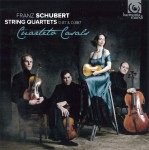 t’s been a long time since any string quartet CD had an impact on me to equal that of the latest issue from the Barcelona-based Cuarteto Casals, but stunning performances of the Schubert String Quartets D.87 and D.877 (harmonia mundi HMC 902121) left me quite lost for words.
t’s been a long time since any string quartet CD had an impact on me to equal that of the latest issue from the Barcelona-based Cuarteto Casals, but stunning performances of the Schubert String Quartets D.87 and D.877 (harmonia mundi HMC 902121) left me quite lost for words.
Despite his tragically short life — or maybe because of it — Schubert managed to plumb depths in his later music that few composers have ever matched, let alone exceeded. The two quartets on this CD are from opposite ends of his career: the E-Flat Major D87 is the work of a 16-year-old who regularly played quartets at home with his family members, while the G Major D887 is Schubert’s final quartet, written in 1826 just two years before his death. The string quartet genre hadn’t really been around all that long at the time — only 50 or 60 years or so — but the emotional and technical distance that Schubert traveled in the 13 years that separate the two works is simply remarkable. The e-flat quartet is a charming and interesting work that owes much to Haydn and Mozart, but the g major is a worthy contemporary of the late Beethoven quartets. And what an astonishing work it is! — powerful, turbulent, full of wonderful theatrical and symphonic effects, and given a rich, fully committed performance by the Cuarteto Casals, whose passion and dynamic range perfectly match the emotional range of the music. Their wonderful playing is beautifully recorded, with perfect balance and just the right amount of resonance. A simply outstanding disc.
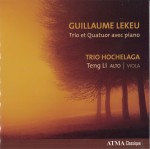 I’m sure most of us have a favourite composer whom we feel is unjustly neglected or underperformed. One such for me is the Belgian-born Guillaume Lekeu, who was just establishing himself in Paris after studying with César Franck and Vincent d’Indy when he died suddenly of typhoid fever the day after his 24th birthday in 1894. ATMA has released a CD of his Trio et Quatuor avec piano (ACD2 2651) featuring the Canadian Trio Hochelaga with the TSO principal violist Teng Li. Both works are very much of their time and clearly in the same style as those of Franck and d’Indy. The Piano Trio is the larger work, and the only completed one of the two; the Piano Quartet was unfinished at Lekeu’s death, and needed an additional few bars from d’Indy to make the second movement performable. It’s a shame it’s incomplete: Lekeu was a late starter, despite his early demise, and it’s clear that a more personal voice was beginning to emerge in this work. The Trio Hochelaga — violinist Anne Robert, cellist Paul Marleyn and pianist Stéphane Lemelin — give full-bodied and committed performances, although I found the violin vibrato to be a bit too wide and heavy at times, threatening to compromise the intonation and making the unison runs with the cello sound a bit out of synch. Overall, the feeling here is not so much one of masterpieces all too few, but more one of future masterpieces unfulfilled and of huge promise cruelly cut short.
I’m sure most of us have a favourite composer whom we feel is unjustly neglected or underperformed. One such for me is the Belgian-born Guillaume Lekeu, who was just establishing himself in Paris after studying with César Franck and Vincent d’Indy when he died suddenly of typhoid fever the day after his 24th birthday in 1894. ATMA has released a CD of his Trio et Quatuor avec piano (ACD2 2651) featuring the Canadian Trio Hochelaga with the TSO principal violist Teng Li. Both works are very much of their time and clearly in the same style as those of Franck and d’Indy. The Piano Trio is the larger work, and the only completed one of the two; the Piano Quartet was unfinished at Lekeu’s death, and needed an additional few bars from d’Indy to make the second movement performable. It’s a shame it’s incomplete: Lekeu was a late starter, despite his early demise, and it’s clear that a more personal voice was beginning to emerge in this work. The Trio Hochelaga — violinist Anne Robert, cellist Paul Marleyn and pianist Stéphane Lemelin — give full-bodied and committed performances, although I found the violin vibrato to be a bit too wide and heavy at times, threatening to compromise the intonation and making the unison runs with the cello sound a bit out of synch. Overall, the feeling here is not so much one of masterpieces all too few, but more one of future masterpieces unfulfilled and of huge promise cruelly cut short.
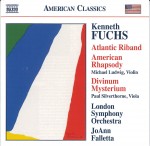 It’s interesting to note how, in recent years, a good deal of contemporary composition in the U.S. appears to have swung back to works with a strong tonal base, often with a strong cinematic feel to them. A recent Naxos CD (8.559723) in their excellent American Classics series features performances by the London Symphony Orchestra under JoAnn Falletta of five works by Kenneth Fuchs, who was born in 1956. This is actually the third Naxos album of Fuchs’ works by this team — Falletta and Fuchs have been collaborating for over 25 years — and it shows a lyrical composer with great imagination and a fine ear for orchestral colour. Two orchestral works — Atlantic Riband and the overture Discover the Wild — open and close the disc. Falletta is joined by her Buffalo Philharmonic concertmaster, the outstanding Michael Ludwig, for American Rhapsody (Romance for violin and orchestra) and by the LSO’s Paul Silverthorne for Divinum Mysterium (Concerto for viola and orchestra), which was written for the performer. Both soloists are in top form, with Ludwig’s beautiful tone again fully evident. The Concerto Grosso for string quartet and string orchestra completes the CD. Despite the occasional suggestion of an English influence — Britten’s Sea Interludes in the Atlantic Riband and the Divinum Mysterium, for instance, or Vaughan Williams’ Lark Ascending in the Rhapsody — this is music firmly in the American mainstream tradition. There are more than a few hints of Copland and the American pastorale; at times, though, you could be forgiven for thinking that you were listening to music for a major motion picture or a top level television news or sports program.
It’s interesting to note how, in recent years, a good deal of contemporary composition in the U.S. appears to have swung back to works with a strong tonal base, often with a strong cinematic feel to them. A recent Naxos CD (8.559723) in their excellent American Classics series features performances by the London Symphony Orchestra under JoAnn Falletta of five works by Kenneth Fuchs, who was born in 1956. This is actually the third Naxos album of Fuchs’ works by this team — Falletta and Fuchs have been collaborating for over 25 years — and it shows a lyrical composer with great imagination and a fine ear for orchestral colour. Two orchestral works — Atlantic Riband and the overture Discover the Wild — open and close the disc. Falletta is joined by her Buffalo Philharmonic concertmaster, the outstanding Michael Ludwig, for American Rhapsody (Romance for violin and orchestra) and by the LSO’s Paul Silverthorne for Divinum Mysterium (Concerto for viola and orchestra), which was written for the performer. Both soloists are in top form, with Ludwig’s beautiful tone again fully evident. The Concerto Grosso for string quartet and string orchestra completes the CD. Despite the occasional suggestion of an English influence — Britten’s Sea Interludes in the Atlantic Riband and the Divinum Mysterium, for instance, or Vaughan Williams’ Lark Ascending in the Rhapsody — this is music firmly in the American mainstream tradition. There are more than a few hints of Copland and the American pastorale; at times, though, you could be forgiven for thinking that you were listening to music for a major motion picture or a top level television news or sports program.
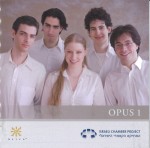 OPUS 1 (Azica ACD-71274) is the impressive debut recording by the Israeli Chamber Project, a group of distinguished young Israeli musicians that was founded in 2008. All of the six members featured on this CD — Itamar Zorman (violin), Shmuel Katz (viola), Michal Korman (cello), Tibi Cziger (clarinet), Sivan Magen (harp) and Assaff Weisman (piano) — are established and experienced performers in their own right, with very impressive backgrounds and résumés. The playing, not surprisingly, is of the highest quality throughout a varied but always interesting program. The Saint-Saëns Fantasie for Violin and Harp, Op.124 from 1907, is one of several pieces that the composer wrote for the harp; it’s a simply lovely work that beautifully illustrates his understanding of the instrument. Martinů’s Chamber Music No.1, written only five months before his death in 1959, is the only work to use all six players. It’s full of folk rhythms, with a slow movement reminiscent of Bartòk’s “night music.” Matan Porat’s Night Horses was commissioned for, and dedicated to, the Israeli Chamber Project, who specifically requested the instrumentation of clarinet, violin, cello and piano to match that of Messiaen’s Quatuor pour le fin du temps. This is its first recording. Sivan Magen arranged Debussy’s 1915 Cello Sonata for cello and harp in 2010, and it works extremely well. Again, this is a premiere recording. A spirited performance of Bartòk’s Contrasts for clarinet, violin and piano rounds out an excellent disc.
OPUS 1 (Azica ACD-71274) is the impressive debut recording by the Israeli Chamber Project, a group of distinguished young Israeli musicians that was founded in 2008. All of the six members featured on this CD — Itamar Zorman (violin), Shmuel Katz (viola), Michal Korman (cello), Tibi Cziger (clarinet), Sivan Magen (harp) and Assaff Weisman (piano) — are established and experienced performers in their own right, with very impressive backgrounds and résumés. The playing, not surprisingly, is of the highest quality throughout a varied but always interesting program. The Saint-Saëns Fantasie for Violin and Harp, Op.124 from 1907, is one of several pieces that the composer wrote for the harp; it’s a simply lovely work that beautifully illustrates his understanding of the instrument. Martinů’s Chamber Music No.1, written only five months before his death in 1959, is the only work to use all six players. It’s full of folk rhythms, with a slow movement reminiscent of Bartòk’s “night music.” Matan Porat’s Night Horses was commissioned for, and dedicated to, the Israeli Chamber Project, who specifically requested the instrumentation of clarinet, violin, cello and piano to match that of Messiaen’s Quatuor pour le fin du temps. This is its first recording. Sivan Magen arranged Debussy’s 1915 Cello Sonata for cello and harp in 2010, and it works extremely well. Again, this is a premiere recording. A spirited performance of Bartòk’s Contrasts for clarinet, violin and piano rounds out an excellent disc.



